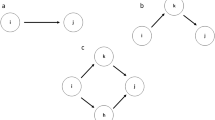Abstract
Workers in a wild in situ colony of the dwarf honey bee, Apis florea, were observed undertaking the following behavior: liquid foraging, pollen foraging, guarding, stinging, fanning and wagging abdomen. Bees of each behavioral class were separately collected and frozen. Collections were made over a period of 10 days. Random samples of brood and workers were also collected. DNA was extracted from each bee and “fingerprinted” using a probe of unknown sequence obtained from an A. mellifera genomic library. Patterns of fingerprints (Fig. 1) were dissimilar among behavioral classes (Tables 1 and 2), strongly suggesting a genetic component to division of labor in this species. This result supports similar findings in A. mellifera in a species that is not troubled by many of the experimental difficulties inherent in A. mellifera.
Similar content being viewed by others
References
Blanchetot AJ (1991) Genetic relatedness in honeybees as established by DNA fingerprinting. J Hered 82:391–396
Calderone NW, Page JR Jr (1988) Genotypic variability in age polyethism and task specialization in the honey bee, Apis mellifera. Behav Ecol Sociobiol 22:17–25
Calderone NW, Page RE Jr (1991) Evolutionary genetics of division of labor in colonies of the honey bee (Apis mellifera). Am Nat 138:69–92
Calderone NW, Robinson GE, Page RE Jr (1989) Genetic structure and division of labor in honeybee colonies. Experientia 45:765–767
Carlin NF, Frumhoff PC (1990) Nepotism in the honey bee. Nature 346:706–708
Crozier RH, Page RE Jr (1985) On being the right size: male contributions and multiple mating in the social Hymenoptera. Behav Ecol Sociobiol 18:105–115
Frumhoff PC (1991) The effects of the cordovan marker on apparent kin discrimination among nestmate honeybees. Anim Behav 42:845–856
Frumhoff PC, Baker J (1988) A genetic component to division of labour within honey bee colonies. Nature 333:358–361
Hamilton WD (1964) The genetical evolution of social behavior. J Theor Biol 7:11–16, 17–52
Hogendoorn K, Velthuis HHW (1988) Influence of multiple mating on kin recognition by worker honey bees. Naturwissenschaften 75:412–413
Koeniger N, Koeniger G, Wongsiri S (1989) Mating and sperm transfer in Apis forea. Apidologie 20:413–418
Moritz RFA (1985) The effects of multiple mating on the worker-queen conflict in Apis mellifera L. Behav Ecol Sociobiol 16:375–377
Moritz RFA, Hillesheim E (1989) Genetic intragroup variance and hoarding behavior in honey bees. Apidologie 20:383–390
Moritz RFA, Meusel MS, Haberl M (1991) Oligonucleotide DNA ingerprinting discriminates super- and half-sisters in honeybee colonies (Apis mellifera L.). Naturwissenschaften 78:422–424
Oldroyd BP, Rinderer TE, Buco SM (1992a) Intra-colonial foraging specialism by honey bees (Apis mellifera) (Hymenoptera: Apidae). Behav Ecol Sociobiol 30:291–295
Oldroyd BP, Rinderer TE, Harbo JR, Buco SM (1992b) Effects of intracolonial genetic diversity on honey bee (Hymenoptera: Apidae) colony performance. Ann Entomol Soc Am 85:335–343
Oldroyd BP, Rinderer TE, Buco SM, Beaman LD (1993) Genetic variance in honey bees for preferred foraging distance. Anim Behav 45:323–332
Oster GF, Wilson EO (1978) Caste and ecology in the social insects. Princeton University Press, Princeton
Page RE Jr (1980) The evolution of multiple mating behavior in honey bee queens (Apis mellifera L.). Genetics 96:263–267
Page RE Jr, Robinson GE (1991) The genetics of division of labor in the honey bee. Adv Insect Physiol 23:117–169
Page RE Jr, Breed MD, Getz WM (1990) Nepotism in the honey bee. Nature 346:706–707
Ratnieks FRW (1990) The evolution of polyandry by queens in social hymenoptera: the significance of the timing of removal of diploid males. Behav Ecol Sociobiol 28:343–348
Robinson GE (1992) Regulated division of labor in insect societies. Annu Rev Entomol 37:635–637
Robinson GE, Page RE Jr (1988) Genetic determination of guarding and undertaking in honey bee colonies. Nature 333:356–358
Ruttner F (1988) Biogeography and taxonomy of honeybees. Springer, Berlin
Seeley TD, Seeley RH, Akratanakul P (1982) Colony defence strategies of the honey bees in Thailand. Ecol Monogr 52:43–63
Shaskolsky DV (1976) Polyandry —a defending factor of the colony against a great number of lethal eggs. In: Apimondia symposium on bee biology, Moscow, USSR: Genetics selection and reproduction in the honey bee. Apimondia, Bucharest, pp 67–71
Sheppard WS, McPheron BA (1991) Ribosomal DNA diversity in Apidae. In: Smith (ed) Diversity in the genus Apis. Westview Press, Boulder, pp 89–102
Sherman PW, Seeley TD, Reeve HK (1988) Parasites, pathogens and polyandry in the social Hymenoptera. Am Nat 131:602–610
Shykoff JA, Schmid-Hempel P (1990) Genetic relatedness and eusociality: parasite mediated selection on the genetic composition of groups. Behav Ecol Sociobiol 28:371–376
Smith CAB (1986) Chi-squared tests with small numbers. Ann Hum Genet 50:163–167
Steel RGD, Torrie JH (1980) Principles and procedures of statistics. McGraw Hill, Tokyo
Stuart RJ, Page RE (1991) Genetic component to division of labor among workers of a Leptothoracine ant. Naturwissenschaften 78:375–377
Woyke J (1963) What happens to diploid drone larvae in a honey bee colony? J Apic Res 2:73–75
Woyke J (1986) Sex determination. In: Rinderer TE (ed) Bee genetics and breeding. Academic Press, Orlando, pp 91–120
Author information
Authors and Affiliations
Additional information
Correspondence to: B.P. Oldroyd
Rights and permissions
About this article
Cite this article
Oldroyd, B.P., Sylvester, H.A., Wongsiri, S. et al. Task specialization in a wild bee, Apis florea (Hymenoptera: Apidae), revealed by RFLP banding. Behav Ecol Sociobiol 34, 25–30 (1994). https://doi.org/10.1007/BF00175455
Received:
Accepted:
Issue Date:
DOI: https://doi.org/10.1007/BF00175455




